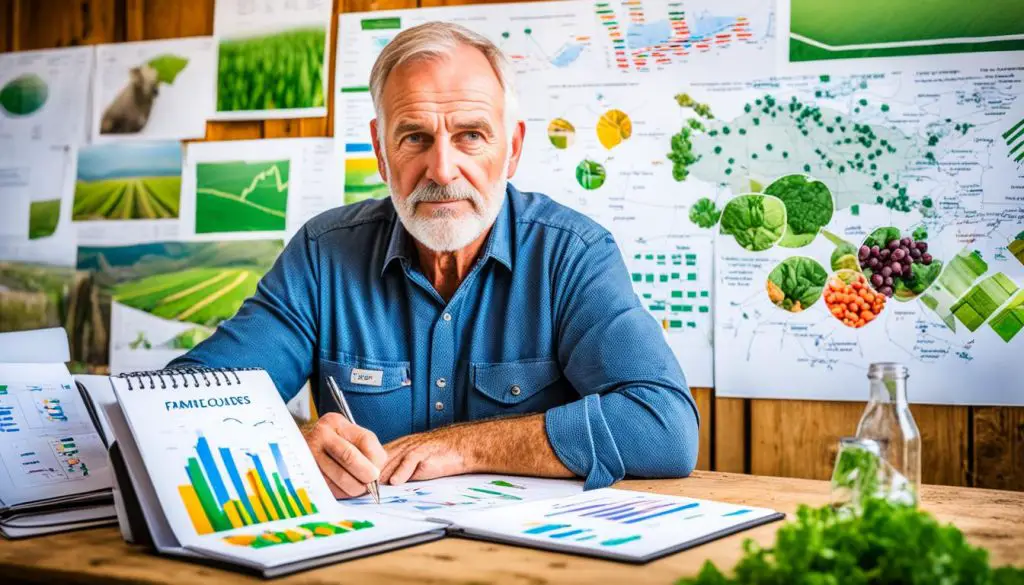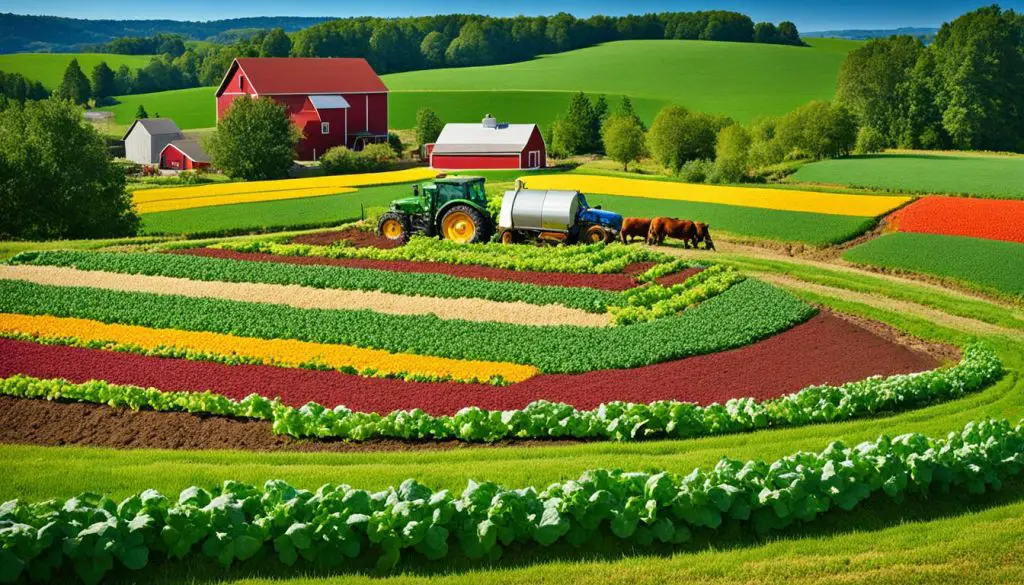Have you ever wondered what it truly takes to turn a small patch of land into a thriving, sustainable farm? While many dream of lush fields and bountiful harvests, the reality often requires careful planning, dedication, and a willingness to start small. Modern agriculture mainly focuses on large-scale monocropping, but for those interested in diverse, sustainable practices, the journey begins with understanding the unique challenges and opportunities of small-scale farming.
Whether you’re looking to cultivate for profit or personal enjoyment, this beginner farming guide will demystify the process, offering practical insights for those with limited initial funds. We’ll explore the actualities of farm life versus the romanticized visions many hold and guide you through gradually scaling your farm operation. Here’s how you can get started on your journey towards sustainable agriculture and a rewarding farming experience.
Key Takeaways
- Understand the realities versus the romanticized vision of farm life.
- Importance of starting small and gradually scaling your farm operation.
- Explore strategies for those beginning with no initial funding.
- Gain insights into sustainable agriculture practices for small farms.
- Learn the significance of careful planning and commitment.
What Qualifies as a Small Farm?
Understanding the nuances of what qualifies as a small farm is critical for those venturing into agriculture on a smaller scale. Various factors, from land size to income, play a role in these definitions and criteria for farming.
Definitions and Criteria
The USDA provides a clear guideline, defining a small farm as one with a gross cash farm income under $250,000. However, other interpretations exist. For example, a hobby farm or smallholding is often considered to be under 10 acres. These definitions and criteria for farming can vary depending on location and individual perspectives.
Size and Land Management
Effective small farm planning requires a keen understanding of land management. For many small farms, practical land usage may also include features beyond arable land such as forests, ponds, and pastures. A one-person or family-operated farm often thrives on careful planning, ensuring sustainable and sufficient crop production within smaller plots.
Income and Market Considerations
Income forms a significant part of small farm planning. It’s vital to consider the market conditions and income potential of small farms. The USDA’s income threshold of $250,000 is just one metric; profitability also depends on crop types, market accessibility, and direct-to-consumer sales strategies.
| Criteria | Small Farm |
|---|---|
| Gross Cash Farm Income | < $250,000 |
| Average Acreage | < 10 acres |
| Key Focus | Self-sustainability and profit |
Clearly understanding these definitions and criteria for farming, along with income and market considerations for small farms, is foundational to developing a successful small farming operation.
Planning Your Small Farm
Launching a small farm involves meticulous planning, considering key factors such as location, cost, and financing. These elements play crucial roles in the farm’s long-term success and sustainability.

Choosing the Right Location
Choosing the right farm location is fundamental. Land prices can vary significantly across different regions, and it’s important to choose a site that balances affordability with soil quality, water availability, and proximity to markets. A thorough understanding of local zoning laws and agricultural regulations can also help avoid potential hurdles.
Creating a Farm Business Plan
A comprehensive farm business plan serves as a roadmap for your agricultural venture. This plan should outline your goals, strategies, and the steps you will take to achieve them. It should include market analysis, crop selection, potential risks, and revenue projections. A well-structured business plan can help you attract investors and secure financing.
Understanding Costs and Financing Options
Understanding costs and financing options is essential. Initial costs may include land purchase or lease, seeds, soil amendments, and equipment. Here’s a simplified breakdown of potential costs:
| Item | Estimated Cost |
|---|---|
| Land | $10,000 – $50,000 |
| Seeds and Soil Amendments | $2,000 – $5,000 |
| Small Equipment | $5,000 – $15,000 |
| Processing Facilities | $3,000 – $10,000 |
| Total Estimated Costs | $20,000 – $80,000 |
For those with limited funds, innovative solutions like leasing land or establishing farming partnerships can substantially reduce initial investments, making your farming venture feasible.
How to Start a Small Farm: A Step-by-Step Guide for Beginners
The journey of starting a small farm begins with a thorough assessment of your personal commitment to the farming lifestyle. This crucial first step involves honest self-reflection on the long hours, physical labor, and dedication required. For anyone interested in beginning a farming operation, it is vital to embrace the challenges and rewards that come with it.
Once the commitment is clear, identifying suitable scales for operations is the next step. This involves selecting the right size for your farm, considering both your experience level and available resources. It is recommended to start small, allowing a learning curve without overwhelming your capabilities. Begin with manageable plots and gradually expand as you become more skilled and confident.
Learning hands-on through experiences cannot be overstated. A step-by-step guide for beginners must emphasize immersing oneself in the day-to-day tasks and responsibilities. Knowledge gained from real-world practice is invaluable and prepares prospective farmers to handle various challenges effectively.
A crucial aspect of starting a small farm is understanding market knowledge. This entails researching and analyzing the market demands in your area. Knowing what crops or livestock are in demand will guide you in making informed decisions about what your farm will produce and how it will be positioned in the market.
Developing a comprehensive business strategy is integral to the success of your farming venture. This strategy should outline your goals, operational plan, and market tactics. Here, aspiring farmers can benefit from creating detailed plans that align with realistic expectations and tangible objectives.
Executing the operational plan effectively means remaining adaptable to changing circumstances. The farming world is dynamic, and market demands can shift. Hence, a flexible approach will help you stay resilient. Gradual expansion, adapting to new challenges, and steadily growing your operation will ensure sustainability and long-term success.
To summarize the essential steps covered in this a step-by-step guide for beginners, the table below provides a clear overview:
| Steps | Description |
|---|---|
| Assess Commitment | Understand the demands of a farming lifestyle. |
| Identify Suitable Scale | Select the farm size based on experience and resources. |
| Learn Hands-On | Gain practical knowledge through day-to-day tasks. |
| Market Knowledge | Research local market demands for produce or livestock. |
| Develop Strategy | Create a business plan with clear goals and tactics. |
| Execute Plan | Implement and adapt the plan to changing conditions. |
Crops and Livestock Selection
When diving into the realm of small-scale farming, careful crop selection and meticulous livestock management are crucial factors for success. Understanding the best choices for your farm’s unique conditions can make a significant impact on productivity and profitability.

Choosing High-Value Crops
Selecting high-value crops can set the stage for financial success. Focus on crops that are in local demand and suitable for intensive production. Vegetables like heirloom tomatoes, herbs, and specialty greens often fetch higher prices at local farmers’ markets. Pioneers like Curtis Stone have showcased how innovative crop selection can lead to substantial returns, even on small plots of land.
Managing Livestock for Small Farms
The intricacies of livestock management start with understanding the relationship between animals and farm size. Small farms benefit from choosing animals that provide multiple outputs, such as chickens for both eggs and meat, or goats for milk and brush control. Proper housing, feeding, and rotational grazing are key practices to maximize the health and productivity of livestock on a limited scale.
Integrating Sustainable Agriculture Practices
Adopting sustainable agriculture practices ensures long-term farm viability and ecological health. Practices like crop rotation, cover cropping, and composting enrich the soil while reducing dependency on chemical inputs. Integrating livestock into these systems can further enhance sustainability by creating natural cycles of fertility and pest control. An eco-friendly approach not only benefits the environment but also creates a resilient farm system.
Farm Business Operations and Marketing
Running a successful small farm requires a blend of strategic investments and innovative approaches. By leveraging essential farm equipment, implementing effective marketing strategies for small farms, and connecting with the community, farmers can optimize their operations and achieve steady growth.
Essential Farm Equipment
Investing in the right farm equipment is crucial for maximizing efficiency without overwhelming the scale of your small farm. Key tools and machinery can include:
- Tractors and plows for land preparation
- Seeders for precise planting
- Irrigation systems for water management
- Harvesting tools to streamline crop collection
- Storage solutions to protect harvested crops
These investments not only improve productivity but also help ensure the longevity and sustainability of your farming operation.
Marketing Strategies for Small Farms
Effective marketing strategies for small farms revolve around building direct relationships with consumers, leveraging local economies, and reducing shipping costs. Consider the following approaches:
- Participating in local farmers’ markets to engage directly with your customers
- Creating a farm-to-table delivery service to provide fresh produce to local restaurants and cafes
- Using social media platforms to promote your farm and products, reaching a broader audience
- Starting a CSA (Community Supported Agriculture) program to secure upfront payments and foster loyal customer bases
These strategies not only boost sales but also strengthen your farm’s presence within the local community.
Connecting with the Agricultural Community
Engaging with the agricultural community is vital for networking, knowledge-sharing, and expanding your farm’s reach. Consider joining local farming co-ops, participating in industry committees, and attending agricultural events. This involvement provides invaluable insights, support, and resources from peers and experts alike.
The right balance of farm equipment, tailored marketing strategies for small farms, and active community engagement can significantly enhance the operational success and growth potential of your small farm. By continuously adapting and evolving your approach, you can navigate challenges and seize opportunities within the dynamic world of small-scale farming.
Conclusion
In our guide to starting a small farm, we’ve navigated through the essential steps and strategies that form the backbone of successful small-scale farming. From initial planning and choosing the right crops to managing livestock and marketing produce, each step is crucial for building a sustainable agricultural operation. Beginning small and growing incrementally allows for the necessary learning and adaptation, ensuring long-term planning for farms aligns with market demands and personal goals.
The success in small-scale farming hinges not just on the day-to-day operations, but also on understanding and integrating sustainable practices. These include soil health, water management, and ecological balance, which are fundamental to long-term viability. Engaging with community, whether through local markets or agricultural networks, is equally important. This interaction fosters knowledge sharing and collaborative opportunities that are indispensable for any farmer.
Ultimately, the journey toward sustainable farming is a continuous learning process. By making informed decisions, remaining adaptable to changing conditions, and embracing sustainable methods, small-scale farmers can achieve their success in small-scale farming. Thorough planning and community engagement will ensure that operations evolve in harmony with both market trends and environmental stewardship, laying a solid foundation for future farming endeavors.
Leave a Reply